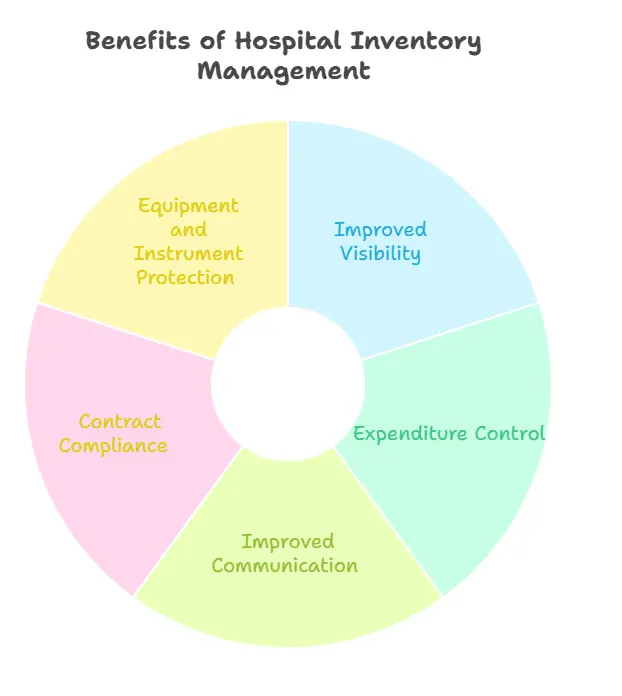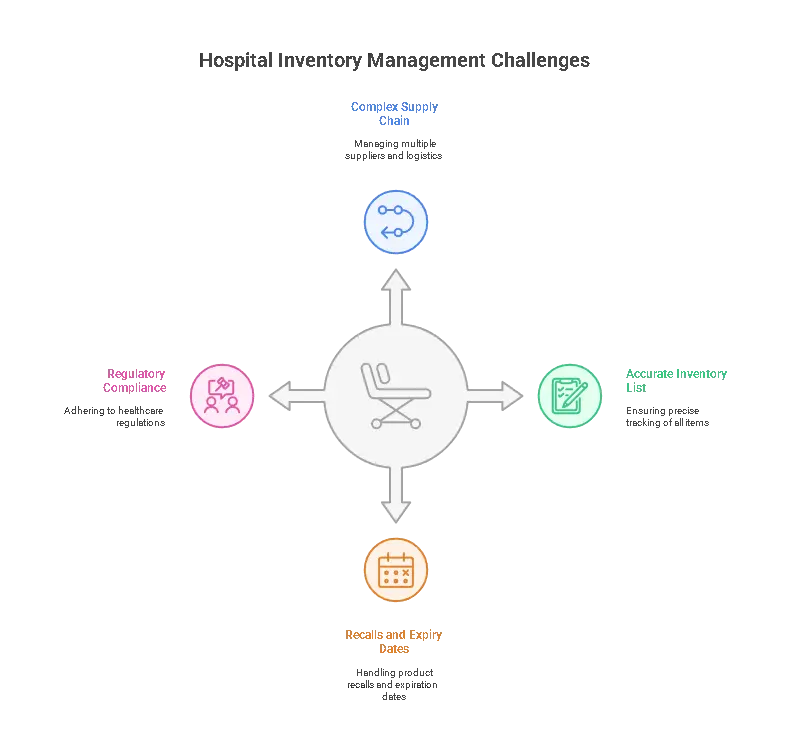Did you know that hospitals and healthcare facilities across the globe spend approximately 25-30% of their annual budget on inventory management? Effective inventory management is important for the smooth functioning of healthcare organizations, which further impacts patient outcomes and financial sustainability.
But what is hospital inventory management? What are its benefits? Moreover, what are the challenges faced by healthcare providers in inventory management? Let’s dive in to explore the answers to all these questions.

What Is Hospital Inventory Management?
Hospital Inventory Management refers to the process of managing and controlling the healthcare’s inventory, purchases, orders, payments, and more. From prescriptions to medical supplies, it keeps track of all the essentials within a healthcare facility.
Hospitals are never aware of the number and type of patients they’re going to deal with. Thus, it becomes essential to manage inventory effectively so as to meet the diverse needs of all the patients.
Inventory management itself is a daunting task. Moreover, in hospitals where doctors, nurses, and other professionals need to pay utmost importance to the patients, inventory management becomes even more difficult. This is why hospitals must implement an inventory management system to look after inventory effectively and precisely.
Why Is It Important?
Unlike retail or manufacturing, hospitals can’t predict exactly how many patients they’ll treat or what their specific needs will be. A sudden emergency, outbreak, or influx of patients can quickly overwhelm the system. Effective inventory management ensures:
- No shortages during emergencies
- Reduced wastage of perishable or expensive items
- Lower operational costs through better purchasing decisions
- Improved patient outcomes due to timely availability of resources
Benefits of Hospital Inventory Management
Did you know that planning the equipment and supplies needed in surgery before time can save about $1800 in every single surgery? Hospital inventory management comes with tons of benefits. Let’s explore the benefits of hospital inventory management in detail.

1. Improved Visibility
A major problem in the healthcare industry involves the lack of visibility within the supply chain. However, with an advanced inventory management system, hospitals can easily track their inventories and overall stock level in real-time. This increased visibility reduces the chances of shortages and stockouts.
2. Expenditure Control
While overstocking of equipment and supplies leads to wastage, understocking leads to rush orders which further increases costs. With inventory management, hospitals can avoid situations of overstocking or understocking supplies. Thus, inventory management plays a vital role in controlling healthcare expenditures.
3. Improved Communication
In large healthcare facilities, the administrative team deals with inventory management which is why they are always aware of the current inventory availability and needs. On the contrary, the care team, including the doctors, nurses, etc., doesn’t have much time to track and manage inventory.
A slight miscommunication between these two teams can risk the life of a patient and create other unnecessary havoc. However, with an inventory management system, both teams can track and manage necessary inventory updates effortlessly in real-time.
4. Equipment and Instrument Protection
Proper inventory management helps protect healthcare equipment and instruments, ensuring their longevity and optimal functionality. Not just this, healthcare facilities can also track their inventories and identify faulty instruments and equipment which need maintenance or replacement.
Moreover, inventory management systems also facilitate proper storage, handling, and monitoring of sensitive equipment, reducing the chances of damage or loss.
5. Contract Compliance
Healthcare facilities often have contracts with suppliers, manufacturers, or distributors. These contracts are for the procurement of medical supplies, pharmaceuticals, and equipment. Effective inventory management enables healthcare providers to comply with these contracts by maintaining accurate records of stock levels, expiration dates, and supplier agreements.
By staying on top of inventory levels, healthcare facilities can prevent stockouts, avoid rush orders, and fulfill their contractual obligations. This helps build strong relationships with suppliers and ensures a steady supply of essential items.
Challenges in Hospital Inventory Management
Proper and efficient hospital inventory management is tricky and comes with its own challenges. Listed below are some of the common challenges of hospital inventory management.

1. Complex Supply Chain
The humongous medical supply chains rely much on third-party logistics and distributors. The worst part about them is that they are not available to adjust to crises and work on tight deadlines. Thus, there may be serious consequences if the required equipment, medications, or supplies aren’t delivered on time.
The best way to solve this problem is to integrate your procurement solutions and inventory. This way, you remove all the unnecessary manual operations within the supply chain. You can also use advanced technologies such as IoT to track your items from the warehouse to the inventory.
Moreover, you can also go for an automated inventory management system wherein all the essential tasks are automated. This removes human involvement and makes the entire process efficient.
2. Maintaining an Accurate List of Inventory Item
Maintaining an accurate and up-to-date list of all the inventory items is a cumbersome task. Moreover, due to the use of standardized processes in record keeping, there are chances of human errors crawling into it and leading to disasters.
The best way to solve this problem would be to implement barcoding or RFID technology which helps in the accurate identification and tracking of a particular item. This way, you can track inventory in real-time, provide automatic updates, and generate reports. It also reduces the number of lost or missing inventory items.
Besides this, it’s important to standardize inventory processes such as storage and disposal. Moreover, you should conduct regular audits and cycle counts to identify discrepancies.
Are you looking for reliable and efficient hospital inventory management software? Look no further! We present to you the best solution to all your inventory management problems – OneSETU by QodeNEXT! By using OneSETU, hospitals can have a 360° view of product movements, locations, and more, making inventory management easier and more efficient. The best part is it’s compatible with ERP, auto reports, DGFT XML generation, WERUM integration, Tracelink integration, and auto inward warehouse.
What more do you want from our functional, easy-to-use master traceability solution? Start managing your inventory better with OneSETU by QodeNEXT!
3. Managing Recalls and Expiry Dates
Hospitals are responsible for maintaining a large inventory of medical supplies, medications, and equipment to meet patient needs. However, these items have limited shelf lives, and their time management is crucial to ensure patient safety, avoid wastage, and comply with regulatory requirements.
To combat this cumbersome task, hospitals must implement an inventory management system with barcode or RFID technology that automatically captures and updates expiry dates. The system can send automated notifications to relevant staff members when items are nearing expiration, enabling proactive actions such as utilization or disposal.
Hospitals can implement inventory rotation strategies such as “first in, first out” (FIFO) to ensure older items are used before newer ones. Additionally, clear communication and coordination among departments and staff regarding inventory availability can prevent overstocking or underutilization of supplies.
4. Regulatory Compliance
Regulatory compliance is a critical aspect of hospital inventory management. Hospitals and healthcare facilities are subject to numerous regulations and guidelines. It governs the handling, storage, and distribution of medical supplies and pharmaceuticals.
Failing to comply with these regulations can result in severe consequences. This includes legal penalties, compromised patient safety, and damaged reputation.
To address regulatory compliance challenges in hospital inventory management, several solutions can be implemented. Firstly, hospitals can utilize robust inventory management systems that track and monitor medication expiration dates, storage conditions, and rotation.
Secondly, implementing secure storage systems for controlled substances, utilizing inventory management software, and conducting regular audits can help manage controlled substances effectively. Thirdly, digital inventory management systems and integration with electronic health records (EHR) streamline documentation and record-keeping processes, thus reducing errors.
Conclusion
Hospital Inventory Management can be a daunting task with various challenges such as tracking inventory, managing stock levels, and ensuring compliance with regulations. However, adopting innovative solutions such as automation, real-time tracking, and predictive analytics can help healthcare facilities overcome these challenges and optimize their inventory management.
However, QodeNEXT has developed a solution to streamline this process with OneSETU. Don’t forget to check out QodeNEXT. Get in touch with us now to help you make the best choice to manage your fleet and optimize your process!
FAQ: Hospital Inventory Management
1. What is hospital inventory management?
Hospital Inventory Management refers to the process of managing and controlling the healthcare’s inventory, purchases, orders, payments, and more. From prescriptions to medical supplies, it keeps track of all the essentials within a healthcare facility.
2. What are the benefits of hospital inventory management?
By effectively managing inventory, healthcare facilities can ensure the longevity of their equipment, comply with supplier contracts, and optimize expenditure while maintaining a steady supply of essential items.
3. What are the key challenges faced in hospital inventory management?
The key challenges faced by healthcare providers in inventory management are:
- Complex Supply Chain
- Maintaining an Accurate List of Inventory Items
- Managing Recalls and Expiry Dates
- Regulatory Compliance
4. What are some best practices and strategies for optimizing hospital inventory management?
Some best practices and strategies for optimizing hospital inventory management are:
- Track Inventory in Real Time
- Organize Your Inventory Regularly
- Use Tags and Labels for Supplies
- Assign Team Responsibilities
- Collect Data and Optimize
- Automate Inventory Workflows
5. How can hospitals improve the accuracy of their inventory records?
Hospitals can improve accuracy by implementing barcode or RFID technology, conducting regular cycle counts and audits, standardizing inventory processes, and training staff on proper record-keeping practices.
6. What role does automation play in hospital inventory management?
Automation streamlines routine inventory tasks, reduces manual errors, enables real-time tracking, and facilitates automated alerts for stock replenishment, expiration management, and reporting, enhancing overall efficiency.
7. How do inventory management systems help in managing medical recalls?
These systems maintain detailed records of batch numbers and expiration dates, generate alerts for recalled items, and assist in quickly identifying and removing affected supplies to maintain patient safety.
8. Why is managing expiry dates critical in hospital inventory?
Proper expiry date management prevents the use of expired or compromised medical supplies and medications, reduces waste, and ensures compliance with healthcare regulations and safety standards.
9. What challenges do hospitals face with regulatory compliance in inventory management?
Hospitals must adhere to strict guidelines on storage conditions, documentation, controlled substance management, and traceability. Non-compliance can lead to legal penalties and jeopardize patient safety.
10. How does visibility in inventory levels benefit hospital operations?
Real-time visibility allows healthcare providers to maintain optimum stock levels, avoid shortages during emergencies, reduce overstocking costs, and improve procurement planning.
11. What technologies are most effective for hospital inventory tracking?
Technologies like RFID, barcode scanning, automated inventory management software, and IoT sensors enable precise tracking, real-time updates, and integration with other hospital systems.






